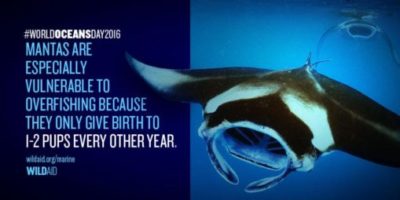By Silvia Sanchez Bor, June 10, 2016
 Did you know that Ecuador has the largest giant manta population?
Did you know that Ecuador has the largest giant manta population?
Illegal fishing continues to pressure Ecuador’s numerous protected areas and fisheries. Funding for conservation efforts on mainland Ecuador is minimal, and due to recent earthquakes, protected area managers have even fewer resources to carry out patrols that protect their marine spaces. WildAid’s work in Ecuador is more important than ever to prevent exploitation of its unique marine life as we celebrate World Oceans Day.
Machalilla National Park along coastal Ecuador is one of the world’s most important sites for manta aggregation as it is home to the largest population of Giant Manta Rays (Manta birostris), estimated at 1,500 individuals. It’s also home to five species of sea turtles, 20 species of whales and dolphins, hammerhead and whale sharks, and countless species of fish and coral reefs.
Listed by the IUCN as “Vulnerable,” the primary threat to manta species is unsustainable fishing. As manta rays have few natural predators, their recent decline is due in large part to direct human predation, driven by the growing demand for their gills or death as bycatch. Compounding matters, mantas are among the slowest to reproduce of all sharks and rays, usually birthing one or two offspring every few years. Their low reproduction rates mean that mantas cannot sustain or survive commercial fishing for long.

Ecuador has been a leader in manta conservation since 2010
Illegal drift gillnet and longline fisheries targeting other species directly threaten mantas in Ecuador. Mantas approach the baited hooks on longlines and get caught on the line as bycatch. Some fishers actively target mantas to profit from the demand for manta gills, used as an ingredient in a so-called “health tonic” called peng yu sai marketed primarily in Guangzhou, China. The hooked mantas attempt to free themselves by thrashing, becoming even further entangled or suffering injuries from the line. By the time fishers go back to check on their mile-long lines, oftentimes the mantas have already suffocated or been so severely injured that they will slowly die after release. A recent WildAid and Shark Savers study observed large numbers of manta rays with life threatening or debilitating injuries from entanglement in Ecuador.
WildAid helps protect mantas in Ecuador using our comprehensive marine protection model to support conservation efforts along the coast and to prevent illegal and unsustainable fishing. We provide electronic monitoring tools that improve surveillance of marine areas at less cost for park rangers. We fund patrols and train park rangers on patrolling strategies, boarding illegal fishing vessels and evidence collection to ensure illegal fishers are apprehended and sentenced for their actions. WildAid also design and deliver outreach campaigns to educate local communities on the benefits of a healthy marine environment and the importance of reducing fishing pressures in specific areas.
All contributions for WildAid’s marine program for World Oceans Day this year (up to $50,000) will be doubled until June 12 thanks to a generous matching donation by a WildAid donor and will be used to support direct marine protection for mantas and other important marine species in Ecuador. Join us now and double your support for Ecuador’s manta population!